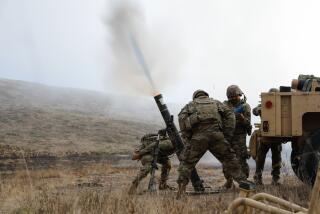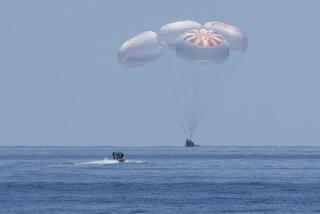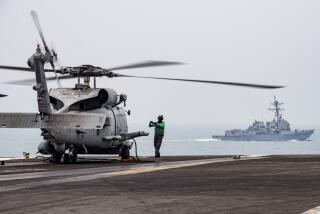Navy Planes Land at New Home
- Share via
POINT MUGU — For the “Wallbangers,” a squadron of high-tech radar planes, it was a homecoming to a place some of them had never been before.
Even so, many of the spouses of these E-2C pilots and navigators were there to greet them Monday, and some mothers and fathers, too, and children hoisting welcome signs as the planes descended onto the tarmac at Point Mugu Naval Air Station.
After a six-month deployment in the Arabian Sea, the last four of 16 E-2Cs moved from San Diego’s Miramar Naval Air Station have finally touched ground at Point Mugu, nearly ending a process that began last July when the first planes arrived.
Next come the moves of families, as the soldiers and their wives and children pack up their San Diego lives and set up camp in Ventura County, trickling in throughout the summer months.
The aircraft arrived on North Island, near San Diego, last week, but Monday was the first time the planes entered their new hangar.
The move will ultimately bring about 1,000 military personnel and 1,500 family members to the base, with a second wave of similar numbers in support crew and family expected by early next year. Some of those soldiers and their relatives will receive on-base housing, but many will seek homes elsewhere.
And although the planes don’t have permanent homes yet--they will eventually be moved from their current hangars to renovated ones--Navy officials are happy to have them all in one place, and off the Marine base.
“We’d been on the fringe” at Miramar, said Cmdr. Rick Beck, who heads the Hawkeyes, the newest squadron at Point Mugu. “We were moved from hangar to hangar, as the Marines tried to make room for themselves. It’s nice to be back with Navy people.”
The move to the Navy base, the new home of the West Coast’s only E-2C wing, is expected to pour millions of dollars into the local economy and bolster Point Mugu’s defense against future military base cuts.
Officials concede that housing could be a sticky issue initially.
“Housing is tight,” said Capt. Randy Bannister, the wing commander. But, he added, the staggered arrival of the squadrons “has been a good thing. It’s a chance to absorb people over a period of time.”
Bannister estimated that 50% to 60% of the squadrons would end up living in base housing. There are four squadrons within this wing, each made up of four planes and their crews.
Among the newest planes the Navy flies, the E-2Cs are essentially lumbering air-traffic controllers in the sky, charting air position and detecting enemy aircraft within a 300-mile radius. With their huge radar antennae stuck up top, the boxy planes look as if they’re carting patio furniture or moonlighting as landing pads for flying saucers.
The relocation to Point Mugu follows an intense several-year lobbying push from local military and civilian boosters who persuaded the Navy to change its plans to shift the planes to Lemoore Naval Air Station in the Central Valley.
For the spouses, most of whom are unlikely to spend more than a couple of years at Point Mugu, having the pilots home is usually more important than the place they arrive.
“I’m accustomed to the leaving and the moving,” said Kim Martier, wife of squadron member Lt. Com. Rick Martier. “But the homecomings are always exciting.”
More to Read
Sign up for Essential California
The most important California stories and recommendations in your inbox every morning.
You may occasionally receive promotional content from the Los Angeles Times.










